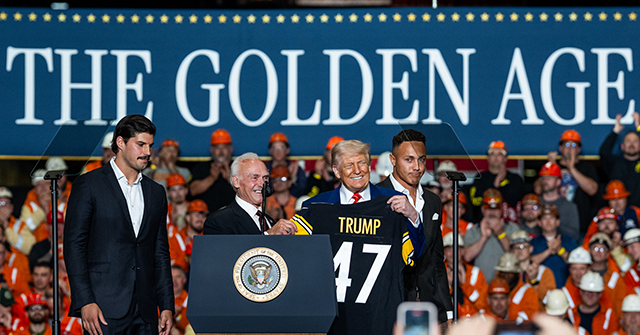Tariffs Reduce Trade and Budget Deficits
The Congressional Budget Office just confirmed something the political class said couldn’t be done: cut taxes, reduce the deficit and lower federal borrowing—all at the same time.
That’s exactly what happens when you pair President Trump’s Big Beautiful Bill with his new America First tariff policy. According to the CBO, the tariffs enacted between January and May of this year would reduce federal deficits by $2.8 trillion over the next decade—more than enough to offset the $2.4 trillion the CBO says would be added by extending the 2017 tax cuts.
In short, Trump’s plan makes imports pay for tax relief.
This marks more than a budgetary adjustment—it represents a potential reordering of the federal revenue structure. For most of American history, tariffs, not income taxes, funded the government. The combination of renewed tariffs and extended tax cuts amounts to a reallocation of the tax burden away from domestic work and production and toward imported goods and global supply chains.
Funding Tax Cuts with Tariffs
The CBO estimates that tariffs will raise $2.5 trillion in direct revenue and save an additional $500 billion in interest payments through reduced federal borrowing. This outpaces the projected cost of the “Big Beautiful Bill,” which includes the permanent extension of the 2017 tax cuts. In practical terms, the tariff policy funds the tax relief.
While critics have long claimed that tax cuts and fiscal discipline are incompatible, the Trump administration’s approach suggests a different model: one in which tariffs create fiscal space for domestic tax reductions. It’s a reversal of the postwar norm in which trade liberalization coincided with rising reliance on income and payroll taxes.
Rebalancing the Tax Burden
This policy mix effectively shifts the burden of funding the federal government away from American workers and businesses and onto the consumption, importing, and production of foreign goods. Instead of taxing labor, savings, or investment, the federal government raises revenue through duties on imported goods. That structure can be economically and politically attractive—especially if the tariffs fall most heavily on products from trade-surplus countries or sectors with underutilized domestic capacity.
It also reflects a strategic goal: encouraging the reshoring of manufacturing and rebuilding domestic supply chains. Tariffs raise the relative return on domestic production, and when paired with tax incentives for business investment, they may drive capital formation in higher-productivity sectors.
CBO’s Estimates and Economic Effects
The CBO’s analysis includes modest macroeconomic effects: GDP is projected to be 0.6 percent lower by 2035 than it otherwise would have been, and inflation is expected to rise 0.4 percentage points above baseline in 2025 and 2026. But those effects are frontloaded and fade over time. After 2026, the CBO projects no further significant inflationary pressure from the tariffs.
That said, the CBO’s approach to estimating the cost of tax cuts is subject to debate. The agency generally does not assume large feedback effects from improved incentives to work, save, or invest. Yet evidence from past tax reforms suggests these effects can be substantial. If the extended tax cuts lead to stronger productivity growth or higher labor force participation, the long-run cost may be significantly lower than the $2.4 trillion headline number.
Similarly, the CBO may underestimate the growth potential from reshoring and reinvestment in domestic manufacturing. Factory jobs tend to be more productive than service-sector employment, and the associated capital expenditures could raise output and tax receipts over time. Higher wages for American workers would also increase tax receipts.
The Interest Rate Effect
One of the more important findings in the CBO’s letter is that tariffs reduce interest costs by lowering the level of federal borrowing. That’s an under-appreciated dynamic. Tax cuts have historically raised concerns about “crowding out” private investment or pushing up rates, but the CBO projects the opposite under this policy mix.
In effect, tariffs not only fund tax cuts, they reduce financing costs across the federal balance sheet. That provides a further cushion against deficit pressures and may help explain why the overall fiscal impact remains positive even after adjusting for lower GDP.
We have voiced skepticism of the CBO model when it comes to the interplay of growth, interest rates, and deficits. Higher deficits do not necessarily mean higher interest rates, and higher rates do not necessarily mean slower growth. But it is notable that even in the CBO model, the Trump policy mix is deficit reducing and therefore lowers interest rates.
Toward a Different Fiscal Architecture
The combined effect of Trump’s trade and tax strategy is a significant departure from recent precedent. If we look at tariffs and tax cuts as parts of an integrated fiscal approach, the fiscal picture for the U.S. changes significantly. Trump’s policies would rebalance the tax code, promote domestic production, and fund the government without increasing the burden on U.S. households or businesses.
President Donald Trump delivers remarks at the U.S. Steel Corporation-Irvin Works in West Mifflin, Pennsylvania, on May 30, 2025. (Official White House Photo by Daniel Torok via Flickr)
Whether this framework proves durable will depend on legal challenges, international responses, and economic outcomes. Importantly, it will depend on the American electorate continuing to vote America First candidates into office. But as a matter of policy logic, the CBO’s analysis suggests that tariffs and tax relief can coexist—and even reinforce one another—within a fiscally responsible agenda.
It’s not only economically sound. It’s politically transformative. Voters don’t want to pay more in taxes, they don’t like ever escalating budget deficits, and they don’t want endless trade deficits. By shifting the burden to imports—especially those from countries that manipulate their currencies, run huge surpluses, and flood our markets—Trump delivers both tax relief and budget responsibility.
Read the full article here
